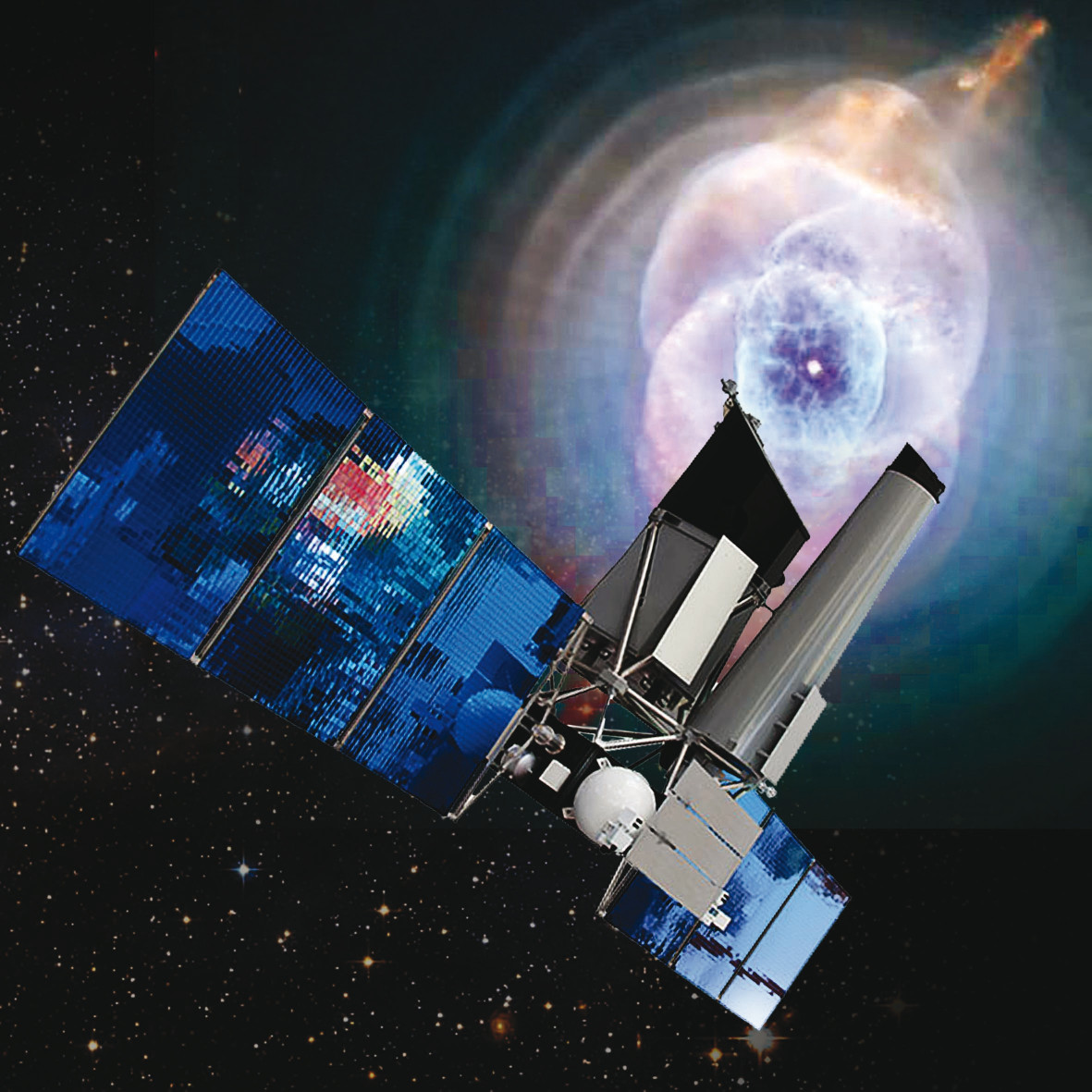Successful launch for eROSITA X-ray telescope

The Russian-German space probe Spektrum-Roentgen-Gamma (SRG) in space. Image: Roscosmos/DLR/SRG/Lavochkin
Russian-German spacecraft now on its way to perform a deep survey of the whole X-ray sky
Today at 14:31 (on 13 July 2019), the Russian-German Spektrum-Roentgen-Gamma (SRG) space mission successfully lifted off from the Baikonur cosmodrome. On-board is the eROSITA X-ray telescope, which was developed and built by a consortium of German institutes supported by Deutsches Zentrum für Luft- und Raumfahrt (DLR) and led by the Max Planck Institute for Extraterrestrial Physics (MPE). Astronomers from the University of Bonn are involved in the scientific preparation and exploitation. 1.5 million kilometres from Earth, eROSITA will perform a deep survey of the entire X-ray sky over the next four years, providing the first ever deep imaging survey of the sky at soft and hard X-rays.
“We built eROSITA to transform the way we see the X-ray sky, and to unravel the mysteries of cosmology and black holes,” states Peter Predehl, Principal Investigator of the X-ray telescope at MPE. “This is the moment when the efforts of the team working for more than a decade come to fruition.” eROSITA is part of the Russian-German Spektrum-Roentgen-Gamma (SRG) space mission, which also includes the Russian ART-XC telescope. The eROSITA X-ray telescope was developed and built at the Max Planck Institute for Extraterrestrial Physics (MPE), together with several University partners. It will perform a deep survey of the entire X-ray sky.
Over a period of four years eROSITA is expected to find 100,000 X-ray emitting galaxy clusters, several million active black holes in the centres of galaxies, and many rare objects such as isolated neutron stars. “The main scientific goal of eROSITA is to reveal the large scale structure of the Universe and how that structure grows over cosmic time. This might help reveal the properties of the mysterious ‘dark energy’ pulling the Universe apart,” explains Andrea Merloni, the eROSITA Project Scientist at MPE. The clusters of galaxies that mark out that structure are filled with gas at temperatures of a million degrees or more. To see that directly, an X-ray telescope is needed.
The telescope has seven “X-ray eyes” at its disposal
eROSITA has seven identical X-ray “eyes”, each combining a mirror module with 54 nested mirror shells and an X-ray camera placed at its focus. The surface of each mirror shell had to be extremely smooth and is coated with gold. The special X-ray cameras, which were also developed and built at MPE, are highly sensitive. This large field of view will allow eROSITA to perform the first imaging all-sky survey in the medium energy X-ray range with an unprecedented spectral and angular resolution. “Earlier this year, we saw the first image of a supermassive black hole sitting in the centre of a galaxy. eROSITA will now tell us when and where this monster and a million others like it grew over cosmic time,“ states Kirpal Nandra, Director of the High-Energy Astrophysics group at MPE.
The development and construction of the eROSITA X-ray telescope was led by the Max Planck Institute for Extraterrestrial Physics with contributions from the Institute for Astronomy and Astrophysics of the University Tübingen, the Leibniz Institute for Astrophysics Potsdam (AIP), University Observatory Hamburg, and Dr. Karl Remeis Observatory Bamberg. The University Observatory Munich and the Argelander Institute for Astronomy (AIfA) of the University Bonn also participate in science preparation for eROSITA. The Russian partner institute is the Space Research Institut IKI in Moskau; NPOL, Lavochkin Association, Khimky near Moskau, is responsible for the technical implemenataion of the whole SRG mission, which is a joint project of the Russian and German space agencies, Roscosmos and the German Aerospace Center (DLR).
The Argelander Institute for Astronomy of the University Bonn has been co-leading the scientific preparations in the galaxy cluster and cosmology working group for years, in particular for predictions on how many galaxy clusters will be discovered with eROSITA and how accurately, e.g., their gas temperatures will be determined, as well as for how precisely the properties of dark energy will be constrained by those observations. The AIfA also coordinates the – for the cosmological interpretation essential – cluster mass determination, and an eROSITA observing program targeting a special triple cluster system.
More Informationen:
eROSITA webpages at MPE:
http://www.mpe.mpg.de/eROSITA
Video with Prof. Dr. Thomas Reiprich:
(Video was filmed and produced by the Astronomy on Tap Bonn team and Laila Linke, MSc at AIfA.)
http://www.youtube.com/watch?v=LEfoQtc66Qc
Contacts for the media:
Prof. Dr. Thomas Reiprich
Argelander Institute for Astronomie (AIfA)
University of Bonn
Tel. +49 228 73 3642
E-Mail: reiprich@astro.uni-bonn.de
Dr. Peter Predehl
Project Manager eROSITA
Max Planck Institute for Extraterrestrial Physics (MPE)
Tel: +49 89 30000-3505
Mobile: +49 151 12113639
Email: prp@mpe.mpg.de
Dr. Andrea Merloni
Project Scientist eROSITA
Max Planck Institute for Extraterrestrial Physics
Tel: +49 89 30000 3893
Email: am@mpe.mpg.de
Prof. Dr. Kirpal Nandra
Director and Head of the High-Energy Astrophysics Group
Max Planck Institute for Extraterrestrial Physics
Tel: +49 89 30000 3401
Email: knandra@mpe.mpg.de
Dr. Hannelore Hämmerle
Press Spokeswoman
Max Planck Institute for Extraterrestrial Physics
Tel: +49 89 30000 3890
Email: pr@mpe.mpg.de
- 13.07.2019